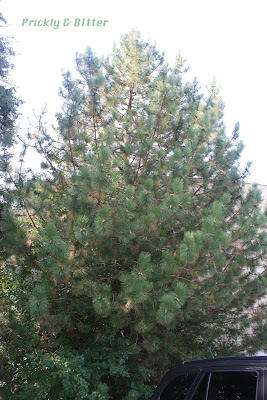Species name: Cucurbita maxima
Common name: giant pumpkin
Location: photo 1 from Veggie Gardening Tips (click HERE), photo 2 from McShanes Nurseries (click HERE), and photos 3 to 6 from The Daily Mail (click HERE)
The giant pumpkin is actually a completely different species of squash than the regular pumpkin. When young (or more "natural" plants that have not been bred specifically for their oversized fruit), they are a completely different colour than regular pumpkins (almost red) and a very different shape. They are often sold in the grocery store as an edible squash variety, and called many names depending on their general appearance: banana squash, buttercup squash, Jarrahdale pumpkin, Kabocha squash, Lakota squash, Arikara squash, and the Hubbard squash. The giant pumpkin species originated about 4,000 years ago in southern North America (southern Texas and northern Mexico, but also perhaps as far south as Nicaragua) but was transported quite early in human exploration to Europe where species like it were already familiar to them. Cucurbita as a genus also has a second area of domestication around Burma, and since that was one of the stops on the great spice route, it was one of the groups of species that had been used by Europeans for centuries.
Believe it or not, the seeds of the giant pumpkin are reported to have medicinal qualities. Fry the seeds in oil then grind into a powder, mix with sugar, then suspend that in castor oil (this sounds incredibly dangerous...I wouldn't EVER recommend that someone ingest castor oil, for any reason!). Drink it, and if you've got intestinal worms they will be no more. I think by the time you've resorted to drinking castor oil you're in pretty bad shape and would resort to any treatment, but to me this sounds like a disaster waiting to happen. There have been no scientific studies to suggest that this home remedy is remotely successful in the treatment of any human disease.
Since today is Halloween, I couldn't possibly pass up one of the most awesome uses of giant pumpkins that have nothing to do with carving them into jack-o-lanterns. Giant pumpkin regattas. Yes, you read that right. There are locations that actually grow giant pumpkins to turn into really awkward kayaks, then have races in them while the "pilots" are dressed in ridiculous costumes. There seem to be points awarded for creativity in decorating your "boat," too, since some of them seem to have some rather unusual additions that wouldn't contribute to the aerodynamics of their vessel. Don't believe me? That's why I have pictures.
Happy Halloween!

















































